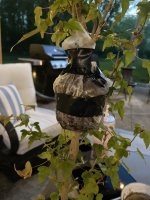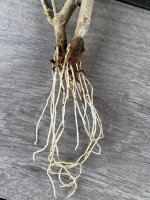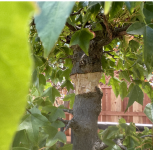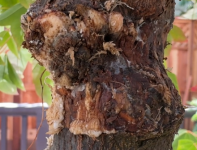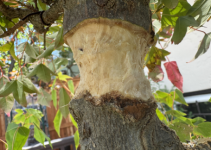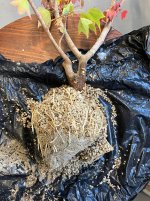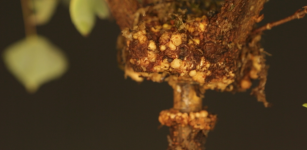Girdling refers to using a wire tourniquet to close off the flow from the leaves above the tourniquet to the roots. Causing a swelling and build up to promote root growth in the desired area.
The air layering method I would suggest is basically Old School. Trident is
less reliable particularly older material so pre-conditioning is important.
!. Bring the health of the tree up with extra care and fertilization the year prior to attempting the air layer.
2. apply a tourniquet to the site during that previous year to begin the process.
3. for best results plan to execute the cut straight across when debarking the selected area.
4. The section removed should be 1 1/2 times the distance of the diameter to be air layer. So 3 inch trunk, cut a section of bark off 4 1/2 inches
5. carefully scrape the surface free of cambium after removing the bark.
6. Score the cut edge unevenly with sharp instrument, clean saw edge for example. This improves the chances of root formation with extra surface area on the cut edge. ( Masakuni technique )
7 Use rooting hormone on the cut edge. If gel apply and let dry for several hours before applying the air layer media and wrap or container. If powder let sit on the edge for an hour as well . You want to ensure the cells on the edge take in the rooting hormone before it is diluted from applying the wet rooting medium.
8. I then apply a wire tourniquet just below the cut edge.
9. For air layering media I prefer medium particle size pumice combined with shredded spaghnum moss. roughly a 1:1 ration. The pumice helps to retain space for roots and air, plus I find it easier to transplant the air layerr without damaging the roots when the air layer is separated.
10. I tend to use larger wrap, more medias with trident to ensure lots of space and uniform moisture retention.
11. My wraps / container always provide drainage/ aeration. ( the bottoms are not lightly wrapped will seep out excess moisture. no pooling.
12 Top of the wrap is usually tighter closure to prevent desiccation.
13. I maintain moisture levels with a syringe when using plastic wrap and through a makeshift lid when using container. One can also use sphagnum on top to prevent desiccation from containers. All methods require monitoring. I do not rely on the root stock to maintain moisture levels in the air layer itself at all times.
I think I included each step, fire away with a question if my rambling is unclear to you.
Example posted below of mature maple with older branch being removed for style improvement. I chose to air layer to provide the same genetic material for future grafting and a secondary tree if successful.
View attachment 612326

